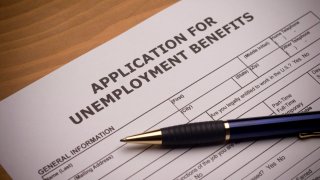
Massachusetts employers added a whopping 58,000 jobs in May, but the state unemployment rate remained one of the nation's highest as most other states showed greater signs of economic recovery.
The month-over-month job gains more than doubled any previous record increase in Massachusetts dating back to at least 1990, according to federal data, but they still represent less than one-tenth of a recovery from the historic 646,700 positions lost in April.
The latest batch of data shows that reopenings of some shuttered economic sectors in May brought scores of jobs back online, although the jobless rate is due to remain at elevated levels for an extended period due to COVID-19 and its myriad economic ramifications.
May's unemployment rate in Massachusetts was 16.3 percent, the second month in a row that the state set a record. April's original estimate of 15.1 percent was at the time the highest rate in the state since at least 1976, and federal labor officials revised the April figure to 16.2 percent in Friday's release.
While the Bureau of Labor Statistics deemed the one-tenth of a percentage point increase not statistically significant, Massachusetts was among a small group of states that did not show improvement in that metric.
Thirty-eight states and the District of Columbia had lower unemployment rates in May than in April, eight others were stable, and just three states -- Minnesota, Connecticut and Florida -- had significant increases.
Only three states reported higher unemployment rates in May than Massachusetts: Nevada at 25.3 percent, Hawaii at 22.6 percent and Michigan at 21.2 percent. Rhode Island and California also reported rates of 16.3 percent, mirroring the Bay State.
Local
In-depth news coverage of the Greater Boston Area.
Nationally, the unemployment rate dropped from 14.7 percent in April to 13.3 percent in May, according to a federal report earlier this month.
Michael Goodman, a MassBenchmarks co-editor and executive director of the UMass Dartmouth Public Policy Center, said Massachusetts may lag other states because of varying impacts of the COVID-19 outbreaks and a slower reopening timeline.
"A number of other states have been much less careful in their reopening plan, which may lead to rosier employment outcomes," he said.
Raw jobs figures displayed a more positive change: total nonfarm payroll employment in Massachusetts increased to about 3.08 million in May, recovering 58,600 of the revised 646,700 jobs lost in April.
The largest gain was 17,400 new jobs in construction, which was one of the first industries given the green light to resume in May after most non-emergency operations were shut down for several months to limit spread of COVID-19.
Leisure and hospitality, which overall has been the hardest-hit field amid the mandatory closures, added 12,400 jobs in May but remains a quarter of a million positions below its employment total one year ago.
Most other industries other than information and government displayed slight gains in hiring last month, according to state data. Goodman said the Friday update included "some good news here that reflects the slow reopening of the state economy," but cautioned that the long-term outlook remains unclear.
"I think in the coming months, we can expect additional sectors to participate in headcount reduction, particularly in state and local government if the fiscal picture doesn't improve," he said. "Another major concern for the private economy is what will happen to those employees currently being paid through the (federal) Payroll Protection Program when those funds expire."
Overall jobs figures and unemployment rates are calculated based on two different data series, and Goodman said it is "not really unusual" for those two figures to move in different directions.
Alan Clayton-Matthews, a Northeastern University economics professor who also contributes to MassBenchmarks, said the trends likely reflect more laid off workers seeking employment.
"A lot of people who lost jobs in March and April left the labor force because they knew looking for work would be futile," Clayton-Matthews wrote in an email. "Leaving the labor force meant that they were not counted as unemployed. Many of these people re-entered the labor force in May, but many did not find jobs and were therefore counted as (newly) unemployed."
"People re-entering the labor force will probably keep the unemployment rate high for many months," he added.
While Massachusetts started reopening in May, the monthly jobs data only captured about a week of the first stage and none of Phase 2, when restaurants started to host diners outside and retail stores welcomed customers in-store.
More frequently updated data, such as new claims for unemployment filed every week, indicate that many in the state are still seeking jobless aid even with more activity underway.
The pandemic, which has already killed more than 115,000 Americans and more than 7,700 Massachusetts residents, has also triggered a national economic crisis.
With so many people seeking unemployment, state labor officials estimate they will have to increase taxes that businesses pay toward unemployment insurance by as much as 65 percent over the next few years.
That additional funding would help cover a deficit in the unemployment insurance trust fund used to pay out benefits projected to reach $3.1 billion by the end of the year and grow to $6.1 billion next year.
Gov. Charlie Baker sought a $1.2 billion loan from the federal government to help cover the costs of jobless aid in May and June. As the fund rushes toward insolvency, Massachusetts has been authorized for $300 million in federal advances -- which will accrue interest -- this month, according to U.S. Treasury data.



